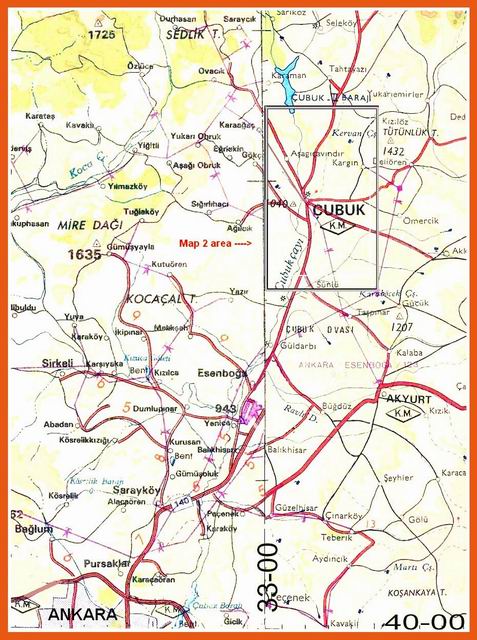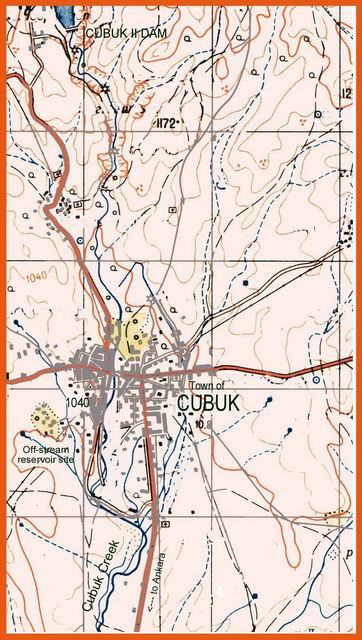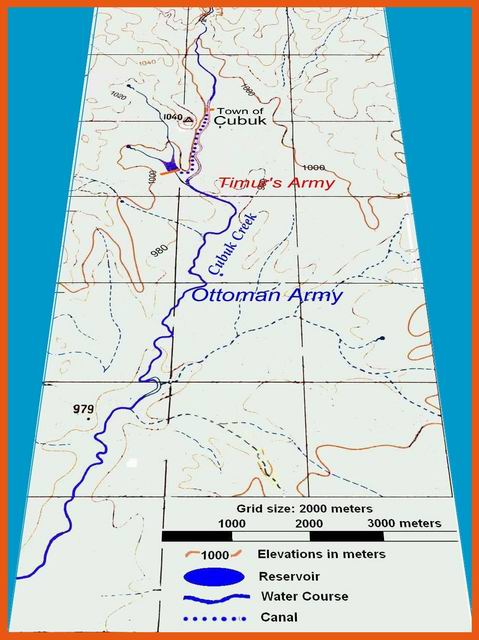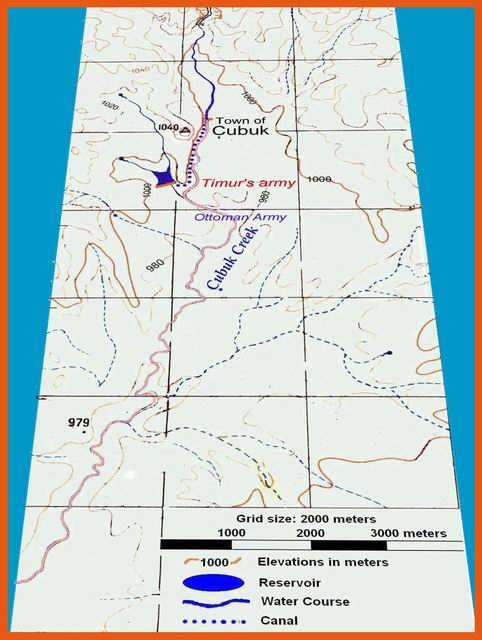
Cubuk Plain (The area between Esenboga and Town of Cubuk)
Events which led to the Battle of Ankara between Timur, the Emperor of the Mongols (Tamerlane) and the Ottoman Sultan Bayazed are well documented. Bayazed was protecting some emirs which revolted against Timur. The latter requested their return. After an exchange of insulting letters between Timur and Bayazed, Timur advanced into Asia Minor. He sacked town after town. The commander at the town of Ankara refused to surrender, and Timur set up camp to the northeast of Ankara on the Cubuk Plain. Bayazed had been racing to face Timur, and after a forced march his army neared Ankara. The area where these events took place is shown in Figure 1.
Contemporary chroniclers have described what ensued with some detail. Timur had fortified his position with dikes and ramparts. There is consensus among historians that Timur's forces diverted the water supply of Bayazed's army and that Bayazed lost the Battle of Ankara because of the thirst of his troops. It is worthwhile to mention that at large armies need reliable and abundant water supplies more than anything else. Foot soldiers were involved in hand to hand combat and cavalry needed water for the horsemen and the horses during the battle, which lasted a whole day in the hot days of July. Cental Anatolia is an arid country, and water was the lifeline of the old armies as the petrol is for modern armies.

Cubuk Plain (The area between Esenboga and Town of Cubuk)
Cubukcay is the main water course that flows on the Cubuk Plain. Hammer, who is one of the best sources about the Ottoman history, states that it was Cubukcay that Timur diverted. This assumes that Timur's army was upstream of the Ottoman Army. The question is how and where the water was diverted. Water will continue to flow unless it is stored somewhere. The base flow of Cubuk Creek is only a few hundreds liters per second. To store this flow for one day one needs a storage less than 50,000 cubic meters. If the depth of storage is one meter the area of such a reservoir would be 50,000 square meters, about one twentieth of a square kilometer. Thus the storage requirement for one day een for a couple of days is not very large.There are two basic methods of storing the water of a water course. Usually a dam is built in a narrow reach of the valley immediately downstream of a good reservoir site. Another method, less common, is to store water in a tributary with a good reservoir site and divert the flow of the main water course with a diversion dam and a canal. Such reservoirs are called off-stream reservoirs. It happens that there is a tributary on the Cubuk valley which is eminently suitable for such a scheme (It was considered as an alternative during the water supply investigations of the City of Ankara in early sixties). This tributary is immediately downstream of the Town of Cubuk on the west bank of the Cubuk Creek. The reservoir area is very flat and a low dike, a few hundred meters long, could easily store the daily flow volume of the Cubuk Creek. It is the only site in the Cubuk Valley where large amounts of water can be stored with minimum amount of earthwork. Timur and his engineers should have immediately seen this opportunity to divert the flow of Cubuk Creek the day of the battle (Figure 1). This map also shows the location of structures to carry out the plan of Timur.
The climate of Central Anatolia (Asia Minor) is
semi-arid. Annual precipitation in Ankara is about 350 mm (eight
inches). Daytime temperatures in Ankara during the month of July reach
35 centigrade (95 degrees Fahrenheit) In summer relative humidity is
very low, and this increases water loss by perspiration. Shallow wells
yield just enough water only for domestic use. Such conditions put a high
price on water for armies, especially when tens of thousands men
and horses need water. Armies have to move along the water courses to
satisfy the thirst of their soldiers and horses (and their elephants
in this case). No battle could take place without an abundant supply of water nearby.

Town of Cubuk and surroundings.
Waiting for the impetuous Bayazed, Timur and
his engineers should have discovered the ideal off-stream reservoir site on the west
of the Cubuk Plain. A diversion dam was probably built on Cubuk Creek, upstream of the tributary
which flowed trough the reservoir. Another low dam was built to close
the off-stream reservoir site. A canal was dug from the diversion dam
upstream which would carry water to the off stream reservoir. Such
engineering works were made possibly by the availability of thousands of
men. In addition Timur had, according to the historians, 32 trained
elephants. Historians (see references) state that Timur fortified his
position with dikes and palisades before the battle. These were in
reality a canal and two low earth dams (one on the Cubuk creek and one
on a tributary water course).When Bayazed arrived, he and his commanders
probably saw the Cubuk Creek flowing. But as soon as the battle started
the gap in the diversion dam was closed. Water was diverted to the canal
and ultimately to the off-stream reservoir.

PHASE I
Timur is waiting for Bayazed. Timur has partially built a diversion dam
upstream with a breach to let the creek continue flowing downstream.
Another low dam is built on a western tributary downstream which has a
large storage capacity . A canal starting from the diversion dam toward
this low dam is constructed to divert water during the second phase.
When Bayazed arrives he sees the Cubuk Creek flowing.

PHASE II
The Cubuk creek downstream was now dry and there was no other
source of water for the Ottoman Army. The battle lasted one full day, in
the heat of July and the Ottoman Army was exhausted and thirsty. The
opening at the middle of the diversion dam is closed. Water starts to
flow into the canal filling slowly the the reservoir side downstream.
Cubuk Creek ceases to flow starting upstream. Ottoman and Mongol Armies
are engaged in combat.

PHASE III
Cubuk Creek is completely dry downstream. Through the day long battle in the heat, Bayazed's well trained army is without water, one of the reasons given by historians for Bayazed having lost the Battle of Ankara.
The remnants of the canal that Timur's army dug and the earth dike should be still there on the right bank of the Cubuk Creek flowing at the foot of Cataltepe in the Town of Cubuk. Because of the extensive urban development taking place in this area it is not easy to identify these features. Early satellite imagery can be useful to identify the remnants of the diversion canal and the earth dike constructed to store water. It is quite probable that the canal was later used to feed the watermills and to irrigate land downstream. Older people in the area probably have seen these before they were buried under the roads and the buildings.
Nowadays two dams built on the Cubuk Creek supply water which Timur wanted to deny to to the Ottoman army to the City of Ankara. The Ottomans never forgot their defeat. The word Mongol, associated with Timur and his army, was never uttered at the Ottoman court again. Did Atatürk, in 1919, have the defeat at Ankara in mind when he chose to make Ankara the capital of the young Turkish Republic to assert once more the resilience of the Turkish Nation?
Hammer, Joseph von: Geschickte des Osmanischen Reich (Pest, 1827-35, 10 vols. French translation by J.J. Hellert Tome I, Livre VI and Tome 2, Livre VII.)
Roloff, Gustav. Die Schlacht bei Angora (1402). Historische Zeitschrift 161, (1940) pages 244-262.
Gibbon, Edward: The Decline and Fall of the Roman Empire. Vol. 3 Chapter LXV. The Modern Library, New York.
Alexandrescu-Dersca, Marie Matilde: La Campagne de Timur en Anatolie, 1402. Publisher: London : Variorum Reprints, 1977.
Dincer, Turgut: Did the Diversion of a Small Water Course Change the Course of History? EOS,Vol.83, Number 31, 30 July 2002.
I sincerely express my thanks to Frank Smitha for his help to create this page